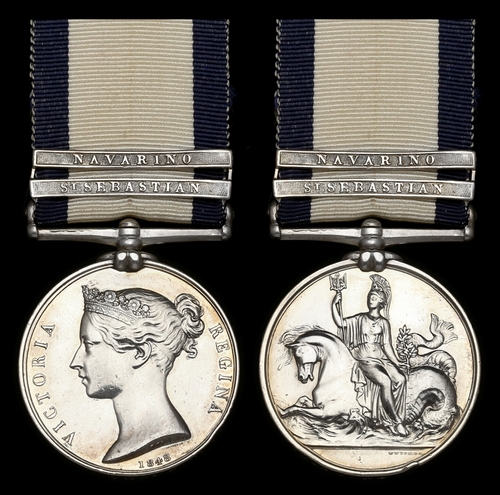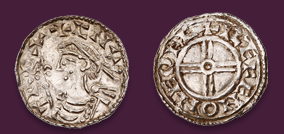
Auction: 25002 - Orders, Decorations and Medals
Lot: 7
Naval General Service 1793-1840, 2 clasps, St. Sebastian, Navarino (Thos. Pippett.), contact wear, an edge nick and a few edge knocks, otherwise very fine
Provenance:
Sotheby's, June 1898.
Hayward, June 1975.
There is no standardised spelling of his surname amongst his records. It appears in several forms including ‘Pipett’, ‘Piepet’, ‘Prepet’, ‘Pippet’,‘Pepit’ ,’Pipet’, and finally as ‘Pippett’ on his medal. Pippett was likely illiterate, and therefore unable to give a spelling of his surname or identify discrepancies on documents.
His is a unique name upon the published rolls.
Thomas Pippett was born circa 1788 reportedly in Guinea, though he later gave his birthplace as Castine, New Hampshire and then Halifax on later documents. We do know that at the time of his enlistment with the Royal Navy on 11 April 1808 he was a resident of St. Salvador where he worked as an apprentice barber. He joined H.M.S. Surveillante when she docked at St. Salvador on her last voyage to Rio de Janeiro, though it is unknown what enticed the young barber to a career at sea. Upon volunteering for service, he gave his age as twenty yet was rated as a Boy 3rd Class – a rank typically reserved for those aged 13-15 – so the officers likely believed him younger. Given that he joined at St. Salvador and was born in Guinea, Pippett perhaps could have been of African descent; St. Salvador had been a longtime port of entry for enslaved people forcibly removed from Guinea.
The first five years of Pippett’s naval career were spent with the 36-gun Surveillante under command of Captain George Collier, with whom he was to see much adventure and excitement. Upon returning to England from South America, Surveillante was tasked with the transport of ‘a most famous passenger’ – none other than Lieutenant General Arthur Wellesley who was summoned to Lisbon to serve as commander of the Portuguese expedition. Surveillante, with both Pippett and the future Duke of Wellington on board, set sail from Portsmouth on 14 April 1809 and arrived on 22 April. The short voyage was marred by bad weather, giving birth to the following notable exchange when Captain Collier requested Wellesley ‘put his boots on and join him on deck’, earning the General’s reply that ‘he could swim better without his boots on and would stay where he was’.
Later that year Surveillante helped to capture the enemy vessel Milan off the coast of the French territory Ile de Re while en route to Guadeloupe. The following year in September 1810 she was on a reconnoitring mission, in company with Constant, of the Loire River when they spotted an enemy convoy and gave chase. One brig sought protection from the batteries of St. Guildas and St. Jacques, however the undeterred Captain Collier immediately dispatched the small boats to attempt to capture her. Despite fire from the batteries the British succeeded in carrying the vessel without the loss of a single man. They repeated the feat the very next night, when Surveillante dispatched two boats to destroy an enemy battery and guardhouse over the river Crache. These were destroyed with gunpowder brought from the ship and without any casualties. Surveillante continued to be involved in much action, earning prize money for her 1 May 1811 capture of French privateer Creole. On 29 July she was appointed to take the convoy for Corunna and in October she aided in the recapture of Bermeo, a port town near Bilboa in Spain.
After the outbreak of the War of 1812 Surveillante helped capture the American ship Zone on 28 January 1812. In February she arrived at Plymouth from Corunna with a convoy transporting 300 deserters from the French armies in Spain. She captured yet another American vessel on 25 May, the schooner Young Connecticut. In June 1812 she was part of Sir Home Popham’s squadron at the reduction of Lequitio and was present in July for various raids at Guateria, which was ultimately relinquished, Castro and Puerta Galetta. These raids forced the French to spend energy in the north of Spain fortifying smaller creeks and villages, taking attention and resources away from Wellington’s attacks in the southern region. Surveillante continued to be busy, and between October 1812 and early June 1813 captured, detained, or aided in the capture of no less than nine enemy vessels, mostly American schooners. Captain Collier succeeded Sir Popham’s command of the northcoast squadron, and from July through September 1813 Surveillante played a pivotal role in the fall of St. Sebastian in orchestrating a number of landing operations. Collier himself wrote of one such operation in July:
‘A successful attack was made upon the island of Santa Clara, at the mouth of the harbour of St. Sebastian, at three o’clock on the morning of the 27th, the boats of the squadron… The only landing place was under a flight of steps, commanded by a small entrenchment thrown upon the west point, and completely exposed to the fire from grape of the whole range of works on the west side of the rock and walls of St. Sebastian. These local circumstances enabled a very small garrison, of an officer and 24 men, to make a serious resistance, by which 2 of our men were killed, and 1 officer of the army, another of the marine, one Midshipman, and 14 seaman and marines were wounded'.
After a notably action-packed five years with Surveillante Pippett was transferred to Porcupine in December 1813, still rated as a Boy. A short time later he was removed to Halcyon and just days later to Leander, thus finding himself once more under Captain Collier who took command of the 58-gun fourth rate frigate on 15 March 1814. With her Pippett was finally advanced Landsman and participated in operations against the American frigates jeopardising British shipping. She captured Rattlesnake off the coast of Nova Scotia in June, the Spanish brig Francisa in July, and American schooner General Putnam in November before departing Halifax on 1 December with a convoy for Castine.
Collier set sail in search of U.S.S. Constitution, who had escaped the British blockade of Boston and inflicted heavy casualties in its fight with British cruisers Cyane and Levant, which were then taken as prizes. He happened upon the three ships on 11 March 1815 in a heavy fog, which obscured their identities, and gave chase as they fled. Constitution’s Captain attempted to distract the British pursuers by breaking off Cyane as a ploy, which was ignored as the British closed in on Levant. Levant subsequently broke away instead and successfully drew their attention, allowing ‘Old Ironsides’ to make her escape. Letting Constitution slip through his fingers was an embarrassing incident for Captain Collier, and the subsequent criticism of this failure tragically led to his death by suicide in 1824.
After the end of the War of 1812, Leander sailed for Quebec and arrived at Portsmouth in July 1815 with a convoy of transports. Later that month she was at Plymouth together with a fleet preparing for the anticipated battle of Algiers. There, Pippett appears to have left Leander and joined Orlando on 10 October, bound for China with a small convoy and was stationed in the Far East for three years. With her, Pippett was rated Ordinary Seaman in January 1816 and was advanced Able Seaman two years later. He left Orlando the next year, and after a brief stint aboard Malabar joined Windsor Castle for about a year and a half during which time he was rated as ‘Bosun’s Yeoman'. He was next mustered to serve with H.M.S. Pyramus on 8 April 1821, which suffered a deadly bout of yellow fever whilst in the West Indies with medical reports on the ship’s outbreak made in December 1821 and again in June 1822. She returned to England and the infections finally dropped, allowing her to return to service in the West Indies and North American Stations.
Pippett was paid off in June 1825 and next joined 50-gun fifth rate Glasgow on 11 August, which was engaged on service in the Mediterranean. From there she was conveniently placed to join the fleet at the Battle of Navarino, fought on 20 October 1827 during the Greek War of Independence (1821-29). At Navarino a combined Turkish and Egyptian armada under Tahir Pasha was destroyed by Admiral Sir Edward Codrington’s allied British, French, and Russian naval force at the port of Navarino (now Pylos), in southern Greece. The Allied ships were better armed than their Egyptian and Turkish enemies and their crews better trained, resulting in a rather quick victory despite being vastly outnumbered. Glasgow sustained no losses during the course of the battle and only two seamen suffered slight wounds. She spent the next year in Corfu, Malta, and Gibraltar before returning to Portsmouth in August 1828, where Pippett was paid off.
After serving for a brief time on board Briton, he joined H.M.S. Donegal at Sheerness on 11 June 1830, and she later joined Vice Admiral Sir Putney Malcolm’s squadron operating a blockade in response to the Belgian Revolution. Pippett next served aboard 40-gun Forte from 5 June 1833, which left Plymouth that August to sail on a number of journeys to Madeira, Bermuda, Canada, the West Indies and the Caribbean and joined Commodore Bell’s blockade of Cartagena from 25 January 1837. After a 30 year career Pippett left the service on 12 April 1837 and was married to Mary Ann More at Stoke Damerel just a few days later on 16 April, afterwards joining the Merchant Navy with whom he served until 1841. However, he rejoined the Royal Navy on 12 January 1841 to serve as a ‘Commander’s Cook’ on board the sloop H.M.S. Ferret which served off the coast of Africa. He was next rated ‘Ward Room Cook’ with the troopship Belleisle from 25 November 1841, which was bound for China. After serving with her for a few years, while out East Pippett left her to join the England-bound Blenheim on 6 September 1842, arriving back home on 11 March.
He was accepted as an ‘in pensioner’ at Greenwich on 20 July 1848, but was later discharged on 2 March 1863 upon his marriage to Jane Jones, his first wife Mary Ann having died in 1856. Pippett himself died on 30 November 1863, just a few months after his second marriage, and was interred at Greenwich Cemetery; sold together with a binder of research and information.
Subject to 20% VAT on Buyer’s Premium. For more information please view Terms and Conditions for Buyers.
Sold for
£2,000
Starting price
£2000




